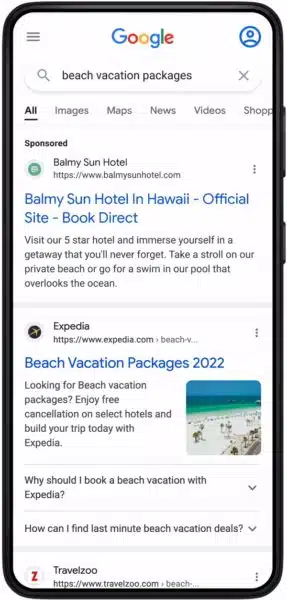Google Ads label is now a bold black text Sponsored label
Google said this it to make the ad label more distinguishable from the organic search results.
Google is rolling out a new search ad label, replacing the black “Ad” label with a new bold black text “Sponsored” label. This is rolling out in conjunction with the new site names and larger favicons in the mobile search results, Google announced.
What is looks like. Here is a screenshot of the new bold black “Sponsored” text ad label for the Google Ads:

Why the change. Google said this is to help “make sense of the information you see is ensuring that ads are clearly labeled.” A more prominent ad label, should do that, the search company said.
The new ad label, labeled “Sponsored,” is now featured on its own line in the top-left corner of Google Search ads.
Some ad label history. We will be updating our visual history of Google ad labels at some point, but for a quick refresher, Google rolled out a new treatment for labeling text ads in mobile search results in May 2019. In January 2020, Google extended that ad labeling and favicon treatment to desktop and quickly faced broad backlash over the further blurring of ads and organic listings, which Google hadn’t seen with the change to mobile. The company almost immediately backtracked and began experimenting with several treatment variations on desktop.
In 2007, Google changed the long-standing shaded background indicating the ads section of the page from blue to yellow. In 2008, it then briefly tried a green background before reverting back to yellow. Google continued to test variations of background colors including bright blue and a light violet. In 2010, violet officially replaced the yellow, but only lasted about a year before yellow reappeared in 2011. In 2013, Google tweaked the yellow to a paler shade, which would close out the era of background shading.
At the end of 2013, Google removed the background shading and began testing a yellow ad label next to each text ad. The yellow “Ad” label rolled out globally in 2014 in a much smaller size than first appeared in the initial testing. In 2016, a new green label marked the first time the color of an ad demarcation matched the color of an element in both the ads and organic listings: the display URL. A year later, Google kept the green, but inverted the treatments so that the font was green with a thin green border on a white background. This past year’s update to the black label does away with the border altogether, further, the display URL is now black to match the “Ad” label.
Note, we also spotted Google testing the Sponsored label many months ago.
Why we care. Google said “this new label and its prominent position continues to meet our high standards for being distinguishable from search results and builds on our existing efforts to make information about paid content clear.”
A more distinguishable ad label may result in changes to your click through rates on your ads, so take notice and track to see if clicks go up or down over a period of time.
Related stories
New on Search Engine Land